Lettuce grows best in cool weather and sunny locations. Spring, mid-summer, and early fall are the times of year to plant lettuce, but you can grow lettuce in the summer even in warm regions if you choose heat-tolerant and bolt-resistant varieties.
There are lettuce cultivars that are ready for picking in 45 days and others that take twice as long. Lettuces fall on a continuum from leaf lettuces that do not form heads to loose-heading butterheads to tight-headed crispheads.
Related articles:
- How to Harvest and Serve Yummy Lettuce
- Lettuce Seed Starting Tips
- Growing Lettuce in Containers
- How to Plant and Grow Lettuce
- Lettuce Growing Problems Troubleshooting

Crisp, tender lettuce is perhaps the most desirable of all salad plants. For the best flavor and texture, it is best grown with close attention to moisture, soil, and climatic requirements. Lettuce was originally a Eurasian annual; it has been developed into many varieties and cultivars with dozens of forms.
For the home gardener lettuce is generally divided into three categories: (1) tight, crisp, nearly white head lettuce with a cabbage-like head; (2) loose, so-called leaf lettuce, where although there is a head, it is looser, and with many more outer green leaves; (3) Cos or Romaine lettuce, which is cylindric, has long, relatively loose leaves and so forms a head which sometimes needs to be tied up.
Of the three categories, the first is the most difficult to grow; the second is easy to grow and a good choice for beginners, and the third is also easy to grow and can stand up to summer heat.
Lettuce is a cool-season crop (except Cos) and is commonly planted in early spring and late summer. (In the South and California, lettuce is often grown in winter.) Most lettuce varieties must mature before the weather gets warm. Midsummer heat, more than other things will cause lettuce to flower. That ruins the chance of heading because the tall flower stalk is forced up through what should be the head. There are bolt-resistant, heat-tolerant varieties for growing in warm weather.
Good Products for Growing Lettuce at Amazon:
- Garden Safe Snail and Slug Bait
- Bonide Sulfur Fungicide
- Monterey BT Caterpillar Killer
- Neem Bliss 100-% Cold Pressed Neem Oil
- Safer Brand Insect Killing Soap
- PyGanic Botanical Insecticide
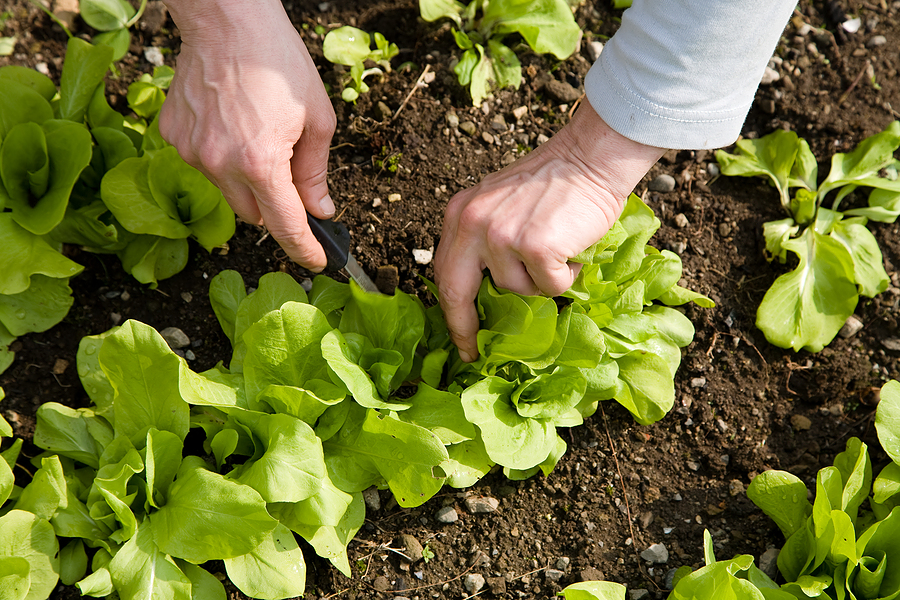
Here is your complete guide to growing lettuce!
Lettuce growing quick tips
- Sow lettuce seeds indoors 4 to 6 weeks before the average last frost date in spring; transplant seedlings to the garden when they are about 4 inches (10cm) tall.
- Direct sow lettuce in the garden in early spring 4 weeks before the average last frost date when the soil temperature is at least 35°F (1.7°C).
- Sow lettuce again when the weather cools in late summer or fall.
- Where the weather stays mild or warm most of the year, grow bolt-resistant, heat-tolerant varieties. Most lettuce seed packets will give the heat tolerance of the variety or cultivar.
- In regions where the weather gets cold in winter, time for lettuce planting to bring the crop to harvest before the first fall frost or grow lettuce through the winter under a plastic tunnel or cold frame.
- Lettuce will be ready for harvest 65 to 80 days after sowing depending on the variety.
- In hot summer regions, time lettuce planting so that the harvest comes in late spring or in autumn.
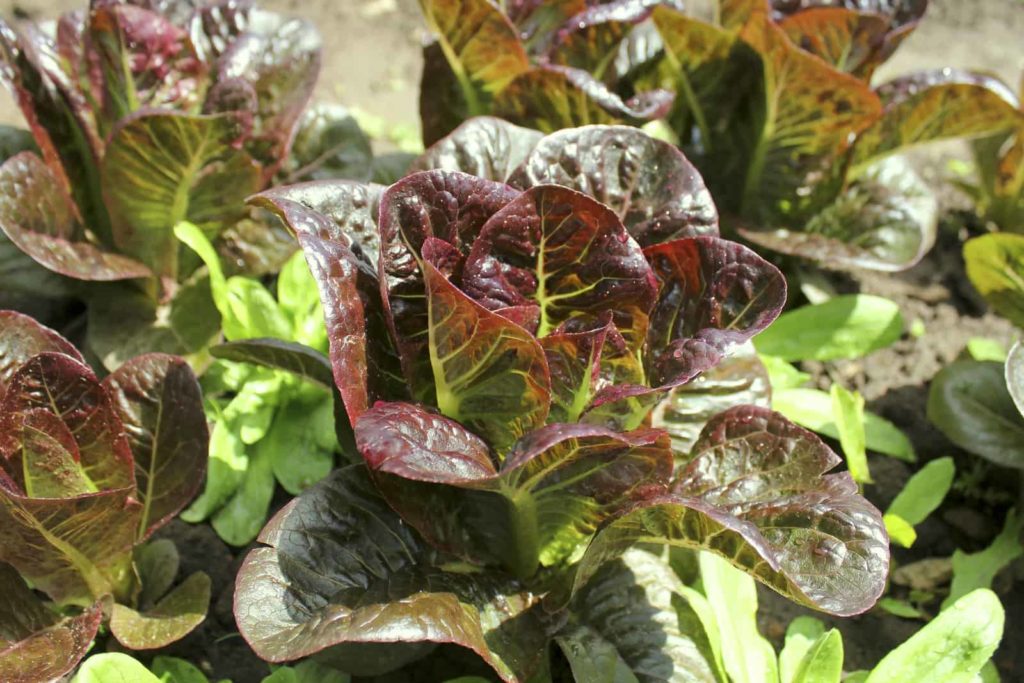
Types of lettuce
Lettuce is a fast-growing, hardy annual with either loose or compact growing leaves that range in color from light green to reddish-brown.
- Leaf or Looseleaf lettuce forms loose, circular patterns, and compact heads; leaves are yellow, green, red, or purplish; leaves can be frilly or smooth. Looseleaf lettuce comes to harvest in 40 to 50 days.
- Butterhead lettuce also called Bibb lettuce or Boston lettuce, forms loose round heads with delicate green to cream-colored leaves at the center. Butterhead lettuce has a soft buttery texture and delicate flavor. Butterhead lettuce comes to maturity in 65 to 80 days; it can be very sensitive to high and low temperatures.
- Romaine or Cos lettuce form leafy green upright cylindrical or oval heads. Romaine lettuce comes to maturity in 80 to 85 days. Romaine lettuce is easy to grow.
- Crisphead or Iceberg lettuce form firm, compact heads of pale green, overlapping leaves. Crisphead lettuce comes to harvest in 80 to 90 days. Crisphead lettuce requires more space than other types of lettuce and can be finicky when it comes to water.
- Celtuce or Stem lettuce forms loose leafy tops on stalks that resemble celery. Leaves are eaten as greens and stalks are eaten like celery. Celtuce comes to harvest in 65 to 90 days.
Good Products for Raised Bed Growing at Amazon:
- Galvanized Raised Bed 8×3
- Cedar Raised Bed 4×8
- Elevated Cedar Planter 4×2
- Walk-In Greenhouse Tunnel 15x7x7
- Row Cover for Freeze Protection 10×30
Where to grow lettuce
Grow lettuce in full sun in cool conditions. A site that receives four to six hours of direct sun each day should work. Lettuce requires afternoon shade in warm regions or hot weather.
Lettuce will grow in average soil but sandy loam is optimal. Prepare the garden bed by tilling or digging to 4 inches deep, clear away large clumps of soil or organic matter, and work in an inch or more of compost. Plant lettuce in raised beds where the soil is very heavy or slow to drain.
Lettuce prefers rich, loose, well-drained soil that does not dry out. Add plenty of garden compost to planting beds before sowing. Add a handful of blood, fish, and bone meal to each square yard/meter before sowing. Lettuce prefers a soil pH of about 6.5.
- Grow lettuce in full sun or partial shade. Use shade cloth to protect lettuce from very warm or hot weather.
- Lettuce prefers well-worked, well-drained soil that is rich in organic matter and moisture retentive. Sandy loam is the best choice of soil to grow lettuce. (Some varieties, like Grand Rapids, do best in heavy soil with considerable clay in them.)
- Add 4 inches (10cm) or more of aged compost or commercial organic planting mix to planting beds in advance of planting. Turn the soil to 6 inches (15cm) deep.
- Lettuce prefers a soil pH of 6.0 to 6.8. Lettuce soil should not be acidic. If a soil test finds that the soil is acidic, it should be limed.
- More important than texture is soil moisture.
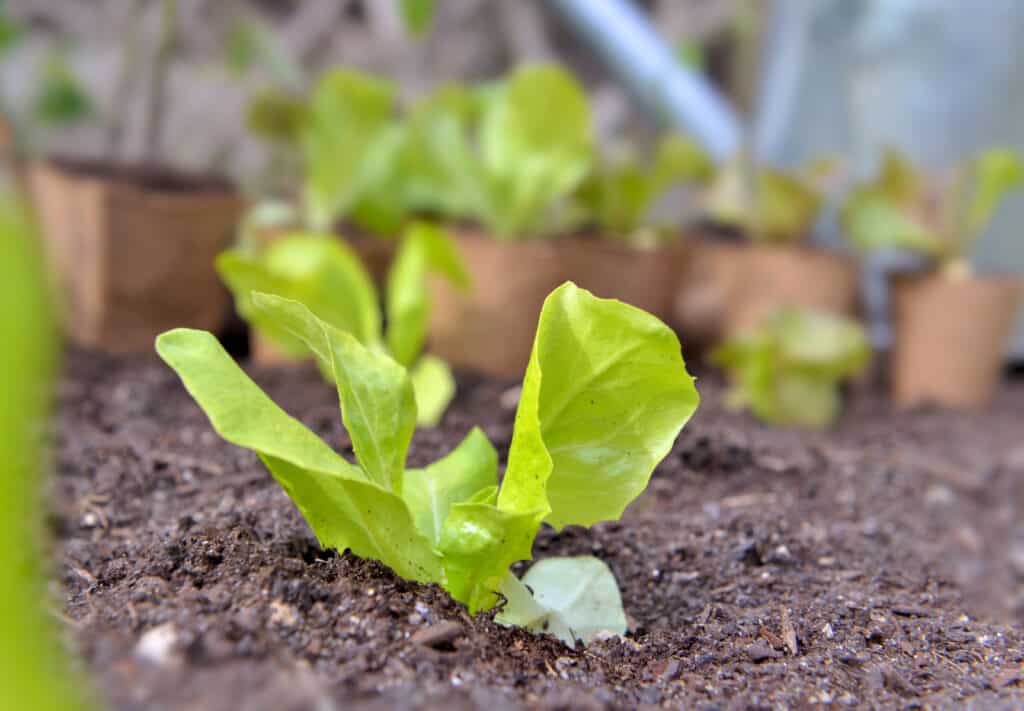
Lettuce planting times
Lettuce does best in cool weather, with temperatures between 60° and 65°F. To grow lettuce where temperatures are higher (especially 80°F or greater), make sure your planting bed gets afternoon shade.
Plant heat-resistant lettuce cultivars where the weather is warm. Shade and water will help prevent bolting.
- Lettuce is a cool-season crop that must come to harvest before the weather gets warm.
- Sowing lettuce seeds should be timed so that they are transplanted to the garden just as soon as the ground can be worked. You need not wait for the last frost of spring in order to set out the seedlings, because, especially in their early stages with will easily endure several degrees of light frost.
- Sow lettuce seed indoors 4 to 6 weeks before you plan to set transplants in the garden—commonly 4 to 6 weeks before the last frost in spring. You can even begin sooner if you like, up to 10 weeks before the last frost.
- Transplant seedlings to the garden when they are about 4 inches tall but not before night temperatures remain above 30°F (-1.1°C).
- Direct sow lettuce in the garden when the soil temperature is at least 35°F (1.7°C) Lettuce seed will not germinate in soil cooler than 35°F (1.7°C).
- Sow lettuce every three weeks for a continuous harvest. As temperatures warm sow bolt-resistant, heat-tolerant varieties.
- Eight weeks before the first expected frost in autumn, switch back to cool-weather lettuce varieties.
- In mild-winter regions, grow lettuce from autumn through winter into spring. Sow succession crops every three weeks through the winter.
- Lettuce will be ready for harvest 65 to 80 days after sowing depending on the variety.
- Succession planting. Make successive plantings every three weeks to ensure a constant supply of fresh lettuce.
Lettuce planting calendar
Lettuce is a cool-weather crop that requires 40 to 50 days to reach harvest. Lettuce will send up a stalk and bolt or go to seed in temperatures greater than 80ºF (27ºC). Bolted lettuce is inedible.
Spring crops. Sow lettuce seed directly in the garden 4 to 6 weeks before the average last frost date in spring. If your growing season is short or hot weather arrives quickly, sow seed indoors in late winter 10 weeks before the average last frost date and transplant seedlings to the garden early so that they mature before the weather gets hot. Small seedlings can be protected by cloches until after the last frost.
Autumn and winter crops. Sow lettuce in late summer for harvest from autumn to early winter. Protect last autumn and winter crops with cloches or plastic tunnels if necessary. Some varieties will over-winter under cloches or in cold frames. In mild winter regions, sow lettuce in autumn for harvest in winter.
Succession growing. Sow lettuce every 2 weeks until early summer to ensure an ongoing supply.
Good Products for Growing Lettuce at Amazon:
- Garden Safe Snail and Slug Bait
- Bonide Sulfur Fungicide
- Monterey BT Caterpillar Killer
- Neem Bliss 100-% Cold Pressed Neem Oil
- Safer Brand Insect Killing Soap
- PyGanic Botanical Insecticide
Planting in a lettuce box
Lettuce does not like warm days and nights, so the cool time of the year is the lettuce season. You can lengthen your growing season dramatically with a lettuce box–that’s a cold frame dedicated to lettuce growing. A lettuce box will protect the earliest and latest plantings, and with a light shade cloth cover, use the lettuce box for summer harvests as well.
If frost is not in the forecast over the next 40 to 60 days tuck lettuce into flower borders. Otherwise, in early spring and autumn, use the lettuce box or be ready to give lettuce some overnight protection when the frost comes. Lettuce leaves stung by frost can be clipped away and you can keep on growing new leaves from the center.
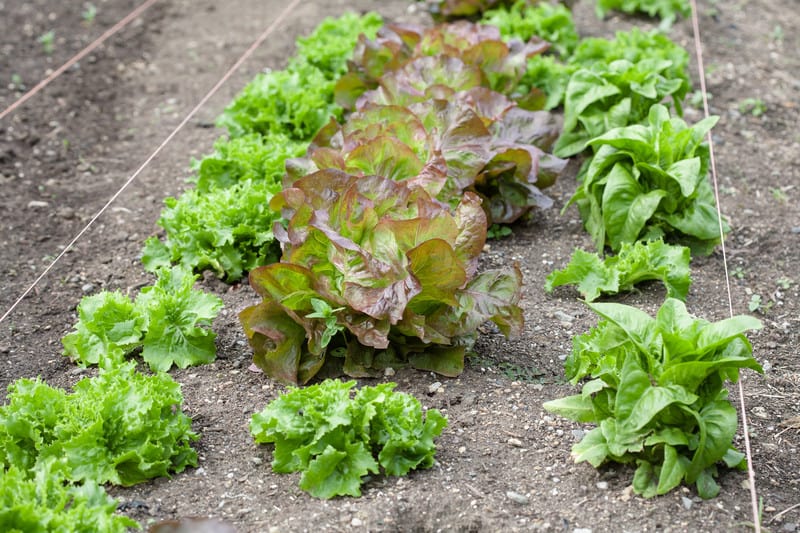
Starting lettuce indoors
The optimal temperature to germinate lettuce seed is 65°F. To germinate lettuce seeds in warmer temperatures, sow seeds in a shallow trench on cool morning, water, and then cover the row with a board to protect seeds from the sun. Lift the board every morning to check for germination; remove when seedlings start to break the ground. Where soil is very warm you can pre-sprout seeds to get better germination or start seeds on a cool garage or garden shed floor.
- Sow lettuce seeds ¼ inch (6mm) deep; cover with finely listed soil. Sow bolt-resistant lettuce ½ inch (12mm) deep.
- Seeds can be broadcast in flats or sown in tiny drills in flats.
- To prevent soil crusting, sprinkle finely sifted compost or organic potting soil over the seeds.
- Place seeded flats under a grow light or in a bright window. Turn flats of young plants every couple of days for even growth.
- In a few days, the plant will be up, and as soon as they are 2 inches high with true leaves; they must be pricked out and spaced about 2 inches in each way. A second and third spacing is advised.
- Plant 6 to 10 heads per person in the household.
Planting lettuce outdoors
Sow lettuce seed ½ inch deep. Thin leaf lettuce seedlings 6 to 8 inches (15-20cm) apart when they are large enough to handle. Thin head lettuce seedlings to 12 inches (30cm) apart. Space rows from 10 to 16 inches (25-40cm) apart. Lettuce that is crowded may bolt. Thinned seedlings can be transplanted to another part of the garden or used in salads.
Thin or transplant lettuce seedlings 7 to 8 inches apart for butterhead varieties, 12 to 15 inches apart for looseleaf cultivars, and 12 to 16 inches apart for romaine and crisphead varieties. Protect seedlings from the cold with floating row covers or in warm weather with shade cloth set over a frame.
- Young lettuce seedlings are best set out in the garden on an overcast day; in any case, they should be watered until they recover from the move.
- Direct sow lettuce in the garden after indoor started plants has been set out.
- Lettuce seeds sown outdoors can be broadcast or in very shallow drills; in either case, covered very lightly with the finest soil.
- Slightly tamp the soil and water it with a fine mist-like spray (a hose spray without a fine nozzle will wash out the seeds).
- The seeds will come up too thick for permanent spacing; they can be thinned as noted above.
- The outdoor sown seed will provide good crops after indoor started plants have been harvested.
- Succession planting can follow beginning about 12 days after the first outdoor sowing.
Thinning and spacing lettuce
- Thin leaf lettuce seedlings from 6 to 8 inches (15-20cm) apart and head lettuce to 12 inches (30cm) apart.
- Space rows 18 inches (45cm) apart.
- Square feet planting: 6 loose leaf plants per square foot, 1 heading lettuce plant per square foot.
- Lettuce must be thinned; lettuce that is too crowded will bolt.
- Transplant rooted thinnings to another row or spot; transplanted lettuce will be set back a couple of weeks but it will come to harvest.
Fall crop lettuce
- For a fall lettuce crop, follow the same procedure for the early crop of indoor seedlings, except that the flats are put outdoors in a cool, shaded place.
- Young plants should be ready to set out about August 15 in northern regions.
More tips: Lettuce Seed Starting Tips.
Container growing lettuce
Lettuce grows well in containers and can be grown indoors in winter. A single head of lettuce can be grown in a 6-inch (15cm) pot. Space lettuce 10 inches (25cm) apart in larger containers. Lettuce grown in containers should be moved to a cool place when the weather warms.
- Lettuce grows well in containers or grow bags. Lettuce makes an attractive addition to a tower garden.
- Grow a single head of lettuce in a 6-inch (15cm) container; set lettuce in larger containers on 10-inch centers.
- Lettuce is heat sensitive so move containers to cooler spots if the temperature rises.
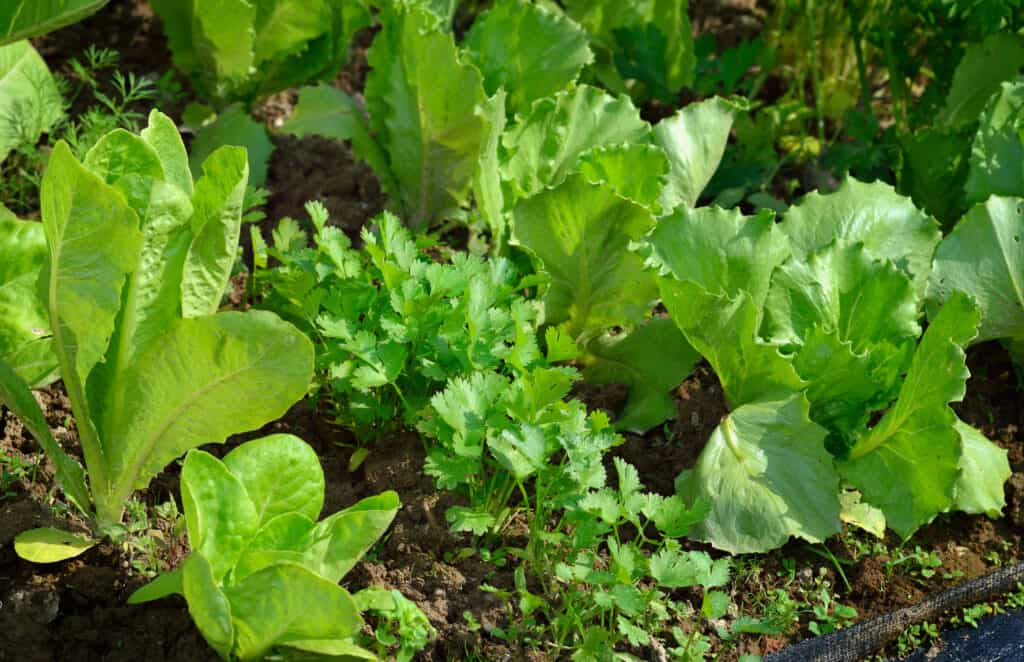
Companion plants for lettuce
- Grow lettuce with carrots, cucumbers, radishes, strawberries, and herbs including cilantro.
Watering lettuce
Lettuce requires moist but not soggy soil. Make sure the crop gets at least 1 inch of water a week; that is slightly more than ½ gallon of water for each plant. Too much water can wash nutrients from the soil and cause lettuce leaves to yellow; add a 15-10-10 fertilizer to green up plants.
Lettuce is shallow-rooted; the soil should not be allowed to dry out. Keep head lettuce well watered when the heads are forming. Use a light mulch of straw or hay around lettuce to keep the soil moist and to keep muddy water from splashing onto leaves.
- Plenty of soil moisture will help induce rapid growth; slow-growing lettuce will not taste good.
- Lettuce has a shallow root system; do not let plants dry out. Keep the garden bed evenly moist but not soggy.
- Regular, even watering is required to form heads.
- If the rain comes to the garden often mulch with straw around the base of plants to keep muddy soil off the leaves.
- A sign that lettuce is not getting enough water is the drying or browning of leaf tips, called tip burn.
Feeding lettuce
Lettuce and other leafy crops need plenty of nitrogen. Feed lettuce with manure tea or fish emulsion once or twice during the growing season to ensure quick and steady growth.
Add plenty of garden compost to lettuce planting beds before sowing seeds. Side dress lettuce every 2 weeks with compost tea during the growing season. Add additional garden compost to the garden before planting a second or third crop during the growing season.
- Lettuce grows best in soil rich in plant food.
- Add aged manure to the lettuce planting bed in advance of planting. Aged manure adds much humus to the soil and thus heightens its moisture-holding capacity as well as enriching it. Turn the manure into the soil so that there is a fine tilth.
- Additionally, feed lettuce with compost tea or manure tea every two weeks throughout the season.
- You can also feed lettuce with aged compost or a commercial organic planting mix added as a mulch or side dressing around plants.

Lettuce care
- Long hot sunny days and high temperatures (80 to 90 degrees F) will cause lettuce to bolt–send up a flower stalk–and go to seed. After bolting, leaves will be bitter-flavored.
- Use shade cloth to partially protect lettuce from warm weather and extreme light intensity. (Place bitter-tasting lettuce in the refrigerator for two and it will taste less bitter.)
- Protect lettuce from cold nights or frost with cloches or row covers.
- Once plants are 4 to 6 inches tall, apply a 2-inch mulch of aged compost around plants to conserve soil moisture, suffocate weeds, and keep leaves clean. Be sure the mulch is pulled an inch or two back from the crown of each plant. Mulching near the crown can cause the plant to rot.
Lettuce bolting
Lettuce—a cool season crop—naturally bolts in warm weather.
When temperatures rise much above 70°F/21°C, lettuce—an annual—will send up stalks, flowers, and set seed, nature’s way of ensuring the next generation. This process is called bolting.
When lettuce and other leafy crops bolt natural sugars depart the leaves for the flowers and seed. When lettuce bolts the leaves are left with a bitter taste, and, for the lover of sweet and tender lettuce, the growing season is all but over.
There are just a few protections against bolting; none are a sure thing. Place shade cloth over your leafy green crop to moderate warming temperatures; irrigate to bring the surrounding soil temperature down; plant in the shade of taller plants; and plant bolt-resistant types and varieties.
Lettuce types in order of natural resistance to bolting are loose leaf, Romaine, butterhead, bibb, and crisphead. When buying lettuce seeds, check packets to make sure the variety you choose is bolt resistant.
One more suggestion: lettuce and other leafy greens started in temperatures consistently below 50°F/10°C have a tendency to bolt later in the season. Keep this in mind for next season.
Bolting (going to seed) will leave lettuce bitter tasting. When lettuce starts to elongate, bolting is just a day or two away. To keep this from happening, pinch off the top center of the plant or wound the roots slightly with a sharp spade by piercing the soil and roots from an angle. This will slow leaf growth and bolting.
Summer lettuce crops can be problematic if you live in a hot or very warm summer region. To grow lettuce in the summer select heat-tolerant or slow-to-bolt varieties and used a midday misting to keep the crop cool.
Cool summer lettuce with a spray of water. You can use misters that will adapt to your drip irrigation. Set the misters at about 5-foot intervals and run them for an hour or two on days when the temperature rises into the 80°sF. The mist will alter the microclimate around your crop without over-watering it.
Lettuce pests
- Lettuce can be attacked by aphids, cutworms, leafminers, cabbage loopers, slugs, and snails.
- Spray aphids away with water; put a collar around each plant to discourage cutworms; trap slugs and snails with a saucer of stale beer set flush to the soil.
- Spray cabbage loopers with Bacillus thuringiensis or neem oil.
- Leafminers are the larvae of a fly; exclude the fly from laying eggs by protecting plants with floating row covers. Pick off and destroy leaves with leafminer tunnels.
Lettuce diseases
To help prevent fungal diseases water lettuce in the morning, especially in cool weather. Water early to ensure moisture evaporates from leaves during the course of the day and is dry by evening.
- Lettuce has no serious disease problems.
- Root and collar rot can occur where the soil stays wet.
More tips: Lettuce Growing Problems: Troubleshooting.
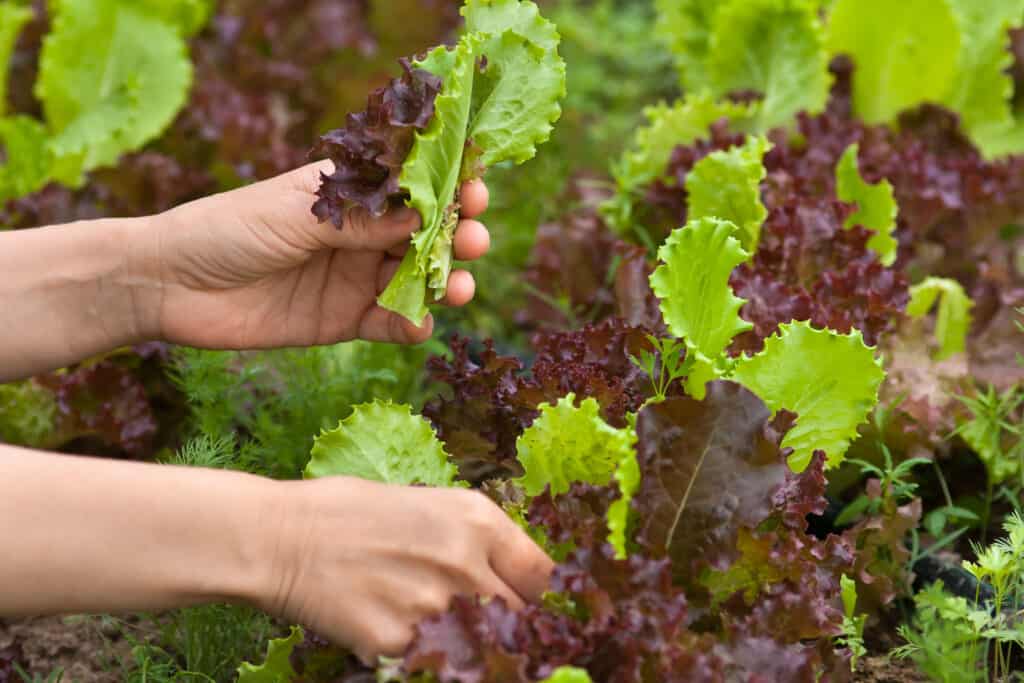
Harvesting lettuce
Lettuce is the crispest if picked in the morning. Looseleaf varieties can be harvested cut-and-come again trimming leaves from the outside first. Heading types should be just firm at harvest; press each head with the back of your hand to test for firmness. Use a sharp knife to cut heads below the lowest leaves, or pull plants out by the roots.
- For the best flavor and crisp texture pick lettuce when you need it and use fresh lettuce right away.
- For loose-leaf varieties, cut outer leaves on a cut-and-come-again basis and allow inner leaves to remain and develop. You can harvest the whole plant at once by cutting it off at ground level.
- Harvest crisphead, cos, and butterhead lettuce when the heads are firm and mature. You can lift the entire plant or cut heads at the crown just above the soil line. Where heads are cut at the crown, smaller leaves will grow for a second harvest.
- Harvest lettuce in the cool part of the day so that it does not wilt immediately. Chilling will crisp up wilted leaves.
Storing lettuce
- Crisphead lettuce will keep in the refrigerator for up to 3 weeks.
- Loose-leaf, butterhead, and romaine lettuce will keep in the refrigerator for 2 weeks.
Kitchen Helpers from Amazon:
- EZ Off Jar Opener for Weak Hands
- Pepper Core Remover Stainless Steel
- Kitchen Utensils – Set of 35
- Rachel Ray Non-Stick Cookware 12pcs
Lettuce in the kitchen
- Lettuce is usually eaten raw in sales or sandwiches, but can also be quickly cooked.
More tips: How to Harvest and Store Lettuce.
Lettuce frequently asked questions
Q: How can I have fresh, tender lettuce all season long?
A: Sow a short row of lettuce seeds every 7 to 10 days. This will ensure new plants will be available regularly.
Q: Should lettuce be started indoors?
A: Lettuce is a crop that is easily started from seed indoors. Start seeds in flats or pots for transplanting into the garden. Begin transplanting as soon as the ground is workable in spring and the last hard freeze has passed.
Q: Can I grow lettuce where summers are hot?
A: In hot summer regions, grow lettuce in spring and fall. To grow lettuce in summer in hot regions, plant in a partially shaded area or use a 50 percent shade cloth screen from 10 a.m. to 4 p.m. In hot areas, plant bolt-resistant varieties that are bread to endure hot spells, not continuous hot weather.
Q: Does lettuce need a lot of water?
A: Perhaps the most important thing lettuce plants need is a constant supply of water. Without water, lettuce can be bitter tasting. Moisten the soil whenever it is the slightest bit dry.
Q: What is the best way to harvest lettuce? What does “cut-and-come-again” mean?
A: Lettuce can be harvested by cutting heads back to just above the roots. If you leave the stump and roots in place, the plants will produce a smaller crop of leaves. Cut-and-come-again means to cut or harvest a few leaves at a time; this method is used with loose-leaf lettuces. Once the plant is about 6 inches tall, you can cut off the outermost leaves for fresh use leaving the remaining leaves to grow on for harvest at a later time.
Five types of lettuce
There are five general types or classifications of lettuce: Butterhead, Crisphead, Looseleaf, Romaine, and Celtuce. Butterhead and Crisphead types have crisp leaves that form compact hearts. Looseleaf and Romaine types grow best in cool weather and do not form significant hearts. Celtuce is a cross between celery and lettuce and is valued for its stem.
Butterhead lettuce
- Butterhead is a smooth, sweet-tasting lettuce with a delicate, buttery texture.
- Butterhead varieties—which are sometimes called cabbage lettuce–form a small, loose, slightly flattened head that looks something like an open rose.
- Butterhead—which is also commonly called by its variety– Bibb, Boston, and Limestone—has broad, crumpled, succulent, pale-green outer leaves and yellow to cream-colored leaves at the center.
- Butterheads form heads as large as 7 inches (18 cm) or more in diameter. They are much easier to grow than crisphead lettuce—the other main type of heading lettuce.
- Batavia-type butterhead cultivars have features between crisphead and butterhead plants.
- The best-known varieties of butterhead lettuce are: ‘Buttercrunch’ is very tender; ‘Boston’ forms a medium-large head of loosely arranged broad light-green leaves; ‘Bibb’ has a smaller more compact head of short dark-green leaves edged with dark red; ‘Limestone’ which is very similar to Bibb but is named for the limestone soil in Kentucky and Indiana where it grows best; and ‘Four Seasons’ (‘Merveille Des Quatres Saisons’) has red outer leaves and pink and cream inner leaves.
- The botanical name for butterhead lettuce is Lactuca sativa var. capitata.
Good Products for Growing Your Garden at Amazon:
- 55 Heirloom Vegetable Varieties–27,500 Non GMO Seeds
- Heirloom Vegetable Seed Collection – 105 Varieties
- Full Spectrum, LED Grow Lights
- Seed Starter Kit with Humidity Dome (120 Cells Total Tray)
- Galvanized Raised Garden Bed with Cover
- Gardzen 10-Pack 10 Gallon Grow Bags
- Captain Jack’s Dead Bug Brew
- Harris Neem Oil Plant Disease Control
- Freeze Protection Garden Mesh Netting Kit
Crisphead lettuce
- Crisphead lettuce has a solid spherical head of tightly-wrapped, pale green leaves that are crisp and succulent. Crispheads have a neutral, watery flavor.
- Crisphead lettuce is most commonly known as head lettuce or iceberg lettuce. The name iceberg was given to crisphead in the 1920s when California lettuce growers began shipping lettuce to far-off markets in rail cars chilled with crushed ice.
- Crisphead lettuce has outer leaves that are dark green and inner leaves that are greenish-white to white. Because crispheads consist of layers of tightly packed leaves, they are more tolerant of heat and keep longer than leaf lettuces.
- Varieties of crisphead include: ‘Great Lakes’, the classic iceberg-type lettuce, ‘Ithaca’, which is a glossy-green, frilled-leaf improved iceberg, and ‘Imperial’ with dark green heads.
- Batavian lettuce is a French type of crisphead that opens like a looseleaf lettuce but later develops a dense head at maturity. It is sweet and juicy without bitterness.
- The botanical name of crisphead lettuce is Lactuca sativa var. capitata.
Looseleaf Lettuce
- Looseleaf lettuces form tight rosettes of individual leaves that are crisp and buttery-flavored. Looseleaf do not form hearts or heads.
- There are many variations in the leaf size, leaf margins, color, and texture of loose-leaf lettuces. Some leaves can be smooth, some curled, some ruffled, some crinkled, and some oak-leaf shaped. Looseleafs can be yellow, green, red, reddish-bronze, or purplish in color.
- Looseleaf varieties are often named for how they look: ‘green leaf’, ‘red leaf’, and ‘oak leaf’.
- ‘Green Ice’ is light green and crispy. ‘Red Sails’ has crinkly leaves edged with bright red.
- ‘Black-Seeded Simpson’ has extra-large frilled leaves. ‘Red Sails’ has heavy, ruffled leaves that are deep red-bronze colored. ‘Lollo Rosa’ has frilly magenta leaves with light green edges. ‘Salad Bowl’ has wavy, light-green, deeply lobed leaves.
- The botanical name for looseleaf lettuce is Lactuca sativa var. crispa.
Good Products for Growing Lettuce at Amazon:
- Garden Safe Snail and Slug Bait
- Bonide Sulfur Fungicide
- Monterey BT Caterpillar Killer
- Neem Bliss 100-% Cold Pressed Neem Oil
- Safer Brand Insect Killing Soap
- PyGanic Botanical Insecticide
Romaine lettuce
- Romaine lettuce has a large, upright, loaf-shaped head with long narrow stiff leaves that look coarse but are crisp, tender, and sweet.
- Romaine lettuce’s outer leaves are dark green and 8-9 inches (20-23 cm) long with a distinctive rib that reaches to the tip. The inner leaves are greenish-yellow surrounding a succulent heart.
- Romaine lettuce has been cultivated for more than 5,000 years. It is sometimes called Cos lettuce—named for the Greek island of Kos (Cos) off the coast of Turkey where it is believed to have originated.
- Romaine varieties are very popular in the United States, southern Europe, and Mediterranean countries. Romaine lettuce was given its name by the ancient Romans and is the chief ingredient of Caesar salad.
- Common varieties of Romaine lettuce are ‘Rouge D’Hiver’ with bronze to deep red, broad, flat leaves, ‘Jericho’ with sword-shaped leaves, and ‘Paris White Cos’.
- Romaine lettuce is usually planted for a fall crop because it does not produce heads during warm weather. In the late summer, Romaine leaves can be tied together to form elongated heads.
- The botanical name of Romaine lettuce is Lactuca sativa var. longifolia.
Celtuce
- Celtuce–also known as stem lettuce–is grown for its succulent, thick stem and tender leaves.
- The name celtuce is a combination of “celery” and “lettuce.” The flavor of celtuce is similar to celery or cucumber or zucchini or artichoke or a combination of the four.
- The stem of celtuce can be pared to remove its bitter skin leaving the soft translucent green core that can be finely sliced and eaten raw in a salad. Celtuce can also be sliced or shredded and stir-fried with other vegetables, pork, chicken, or prawns.
- The stem of celtuce can grow about 10 to 12 inches (25-30 cm) long. There are soft green lettuce-like leaves at the end.
- The young leaves of celtuce can be eaten raw in salads, but the leaves become tough, bitter, and inedible as they mature.
- Celtuce—which is sometimes called asparagus lettuce for its stalk’s resemblance to an asparagus spear–is thought to have originated in China. Celtuce grown in China is sometimes pickled and eaten as a side dish.
Lettuce varieties to grow
There are dozens of varieties of each type of lettuce. Ask your cooperative extension for specific recommendations and the best options for your region.
- Loosehead varieties called butterhhead or Boston include ‘Buttercrunch,’ ‘Bibb,’ and ‘Gem’; these will mature in 60 to 75 days.
- Crisphead varieties that form cabbage-like heads include ‘Iceberg,’ ‘Great Lakes,’ and ‘Ithaca’ which mature in about 75 days.
- Looseleaf varieties that are suited for cut-and-come again harvests include ‘Oakleaf,’ ‘Salad Bowl,’ and ‘Red Ruby’ which mature in 40 to 60 days.
- Romaine or cos varieties–with long narrow leaves and heads–include ‘Rosalita,’ ‘Apollo,’ and ‘Ballon’ which mature in 75 or more days.
Here are varieties often grown in the home garden:
- Loose-Leaf: ‘Black-Seeded Simpson’ (45 days); ‘Grand Rapids’ (45 days); ‘Oakleaf’ (50 days); ‘Salad Bowl’ (45 days); ‘Ruby’ (45 days); ‘Red Sails’ (45 days), ‘Tango’, ‘Slobolt’.
- Butterhead: ‘Big Boston’ (75 days); ‘Buttercrunch’ (75 days); ‘Summer Bibb’ (62 days); ‘Ermosa’; ‘Esmeralda’; ‘Nancy’.
- Romaine or Cos: ‘Parris Island Cos’ (73 days); ‘Valmain’ (85 days); ‘Green Towers’; ‘Valley Heart’; ‘Red Eyes Cos’, ‘Red Romaine’.
- Crisphead or iceberg: ‘Great Lakes’ (95 days); ‘Ithaca’ (75 days); ‘Iceberg’; ‘Crispivo’.
- Celtuce or stem lettuce (80 days). The botanical name Lactuca sativa var. augustana is grown for its succulent thick stem and tender leaves.
Heat-tolerant and bolt-resistant lettuce varieties
- Buttercrunch butterhead lettuce. Smooth green leaves, heat tolerant. All-America winner. Ready for harvest in 68 days.
- Summer Bibb butterhead lettuce. Thick leaves, creamy and firm interior, slow to bolt. Ready for harvest in 77 days.
- White Boston butterhead lettuce. Light-green, medium-sized, smooth outer leaves with wavy edges, mild-flavored, good in warm humid conditions. 57 days to harvest.
- Black Seeded Simpson leaf lettuce. Older variety, light-green lightly crumpled leaves on large upright plants, heat and drought tolerant. 45 days to harvest.
- Red Salad Bowl leaf lettuce. Bronze burgundy red is also known as Red Oak with deeply lobed leaves and good heat tolerance. 55 days to harvest.
- Salad Bowl leaf lettuce. Lime-green rosettes, deeply notched with delicate tender leaves. Good resistance to bolting. 55 days to harvest.
- Oakleaf leaf lettuce. Medium-dark green deeply lobed oak leaf-shaped leaves in tight rosettes. Very good resistance to hot weather. 50 days to harvest.
- Ruby leaf lettuce. Deep red variety with large frilled savoy leaves and bright green centers. Good bolt and heat resistance. 55 days to harvest.
- Cimmaron romaine lettuce. Deep red romaine, tally cylindrical plants to 12 inches, crisp and tender. Excellent bolt resistance. Use as baby leaf. 35 days to harvest.
- Grand Rapids TBR leaf lettuce. Early, leaves frilled, deeply cut, and light green, heat resistant. 45 days to harvest.
- Green Ice leaf lettuce. Dark, glossy green, fringed leaves, heat resistant. 45 days to harvest.
- Slobolt leaf lettuce. Crumpled and frilled leaves, good warm-weather lettuce. 45 days to harvest.
- Great Lakes crisphead lettuce. Large, erect leaves are bright green and fringed, high-quality heads, slow to bolt. All-America winner.
- Ithaca crisphead lettuce. Firm heads, with mild heat resistance, does well in midsummer. 72 days to harvest.
About lettuce
- Common name: Lettuce, crisphead lettuce, Butterhead lettuce, stem lettuce (celtuce), leaf lettuce, cos, romaine
- Botanical name: Lactuca sativa
- Family: Asteraceae (Compositae)
- Origin: Near East
More tips: How to Grow a Salad Garden
Lettuce articles at Harvest to Table:
How to Harvest and Serve Yummy Lettuce
Lettuce Growing Problems: Troubleshooting
Garden Planning Books at Amazon:
- Vegetable Garden Almanac & Planner
- Kitchen Garden Grower’s Guide Vegetable Encyclopedia
- Tomato Grower’s Answer Book
- Vegetable Garden Grower’s Guide
More how to grow articles:
Learn how to plant, grow, and harvest your favorite vegetables. Click below for all you need to know.
- Artichoke
- Arugula
- Asparagus
- Beans, Snap
- Beets
- Broad Beans
- Broccoli
- Brussels Sprouts
- Cabbage
- Cantaloupe — Melons
- Cardoon
- Carrots
- Cauliflower
- Celeriac
- Celery
- Chard
- Chayote Squash
- Chickpeas
- Chicory
- Chinese Cabbage
- Collards
- Corn Salad
- Corn, Sweet
- Cresses
- Cucumbers
- Eggplant
- Endive and Escarole
- Fava Beans
- Florence Fennel
- Garbanzo Beans
- Garlic
- Horseradish
- Jerusalem Artichoke
- Kale
- Kohlrabi
- Leeks
- Lettuce
- Lima Beans
- Melons
- Mizuna
- Mustard Greens
- New Zealand Spinach
- Okra
- Onions
- Parsnips
- Peanuts
- Peas
- Peppers
- Potatoes
- Pumpkins
- Radicchio
- Radishes
- Rhubarb
- Rutabaga
- Salsify
- Shallots
- Sorrel
- Southern Peas
- Soybeans
- Spinach
- Squash, Summer
- Squash, Winter
- Sunchokes
- Sweet Potato
- Swiss Chard
- Taro
- Tomatillo
- Tomatoes
- Turnips
- Watermelon
- Zucchini















